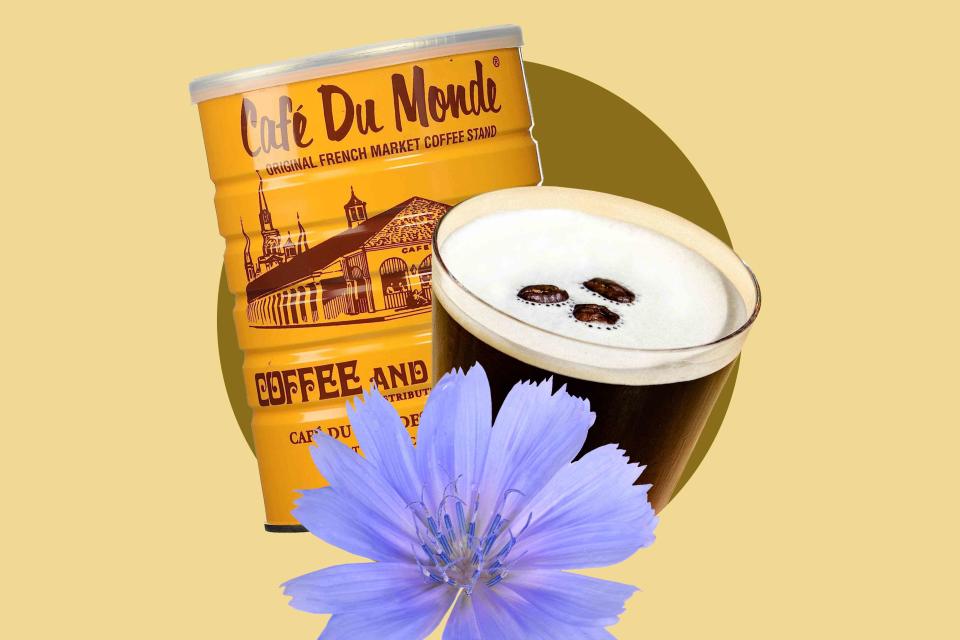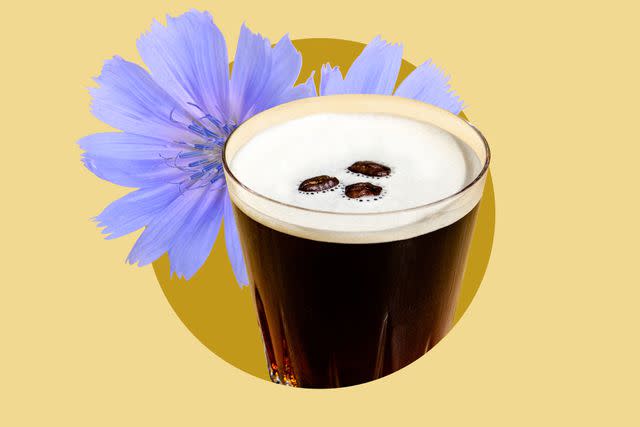What Is Chicory, and Why Is It Blended in Coffee?
New Orleans knows about the magic of this flowering plant and you should too.

Food & Wine / Cafe du Monde / Tim Nusog / Getty Images
If you’ve ever visited Cafe Du Monde in New Orleans for coffee and beignets, you might have noticed that the coffee tastes a bit different than what’s served at other cafes. You’re not mistaken — Cafe Du Monde and other cafes in New Orleans blend their coffee with chicory. But what is chicory exactly, and why is it blended with coffee?
What is chicory?

Wirestock / Getty images
Chicory is a flowering, herbaceous plant that has long been used in both food and drinks.
Although it’s native to Europe, North Africa, and Western Asia, it’s now cultivated all over the world where its leaves and roots are utilized in a variety of ways. The plant is leafy and has flowers that are commonly blue or white. The entire plant, including the stems, leaves, and roots are edible.
“Chicory leaves have a ton of culinary uses — endive with steak tartare, radicchio dressed in a vinaigrette alongside a veal Milanese, or puntarelle (the sprouts of Catalonian chicory) served with anchovies, which have been eaten in similar styles since Roman times,” says New Orleans bartender and partner at Manolito, Nick Detrich. “In beverage, it is often steeped in teas, added to blends of bitter roots for various amari, or brewed with coffee to enhance coffee’s bitter notes,” he says.
Coffee and chicory

Cafe Du Monde
Chicory is caffeine-free, so people who are unable to consume caffeine can drink it as a substitute for coffee.
"During the Union blockade of New Orleans during the American Civil War chicory provided a way to stretch coffee rations."
The root of the chicory plant is what’s most commonly used in the United States. When raw, it’s extremely bitter, so it’s often roasted, boiled, or dried to lessen the bitterness. The roasted, dried, and ground root is commonly used as a substitute for or additive in coffee. The root, when roasted, has a similar flavor and aroma to freshly roasted coffee, so it's a natural pairing.
“It’s always played a role where coffee has been scarce, often used to stretch coffee when rationed,” says Dietrich. “It also is brewed in many spiced coffees of various cultures in the Middle East. Ricoré (a Nestlé product created in the 1950s) is still sold in France, a nearly 50/50 blend of chicory and coffee.”
Related: 11 Iconic New Orleans Cocktails
The chicory connection to New Orleans
In the United States, no location is more closely associated with chicory than New Orleans.
“The French began using chicory root blended with coffee in the late 17th century and it made its way to Louisiana through those foodways,” says Dietrich. During the Union blockade of New Orleans during the American Civil War chicory provided a way to stretch coffee rations. The rationing and use of chicory during this time played a big role in establishing the plant as an indispensable part of the culinary fabric of the city.
“New Orleanians love big flavors, and intensifying coffee’s bitterness makes a lot of sense in the culinary landscape of New Orleans,” says Dietrich.
Chicory in cocktails

Food & Wine / Tim Nusog / Getty Images
With how closely chicory is woven into the culinary fabric of New Orleans, it's no surprise that creative bartenders in the Big Easy’s myriad craft cocktail bars have also found ways to use it when crafting cocktails.
Like in food, chicory has a versatile approach, but its innate bitterness makes it the perfect bittering agent to balance other flavors.
“As it can have an overwhelmingly bitter flavor, it’s best to use it in brief steeps — like in a syrup, or infusion,” says Dietrich. “It’s excellent in boosting the richer notes in Italian vermouth [when making] Manhattans and Boulevardiers. It can make for an excellent addition to amari, a few dried pieces steeped in a Southern Italian or Sicilian amari makes for a delicious aperitif.”
Whether its leaves are tossed into a salad or its roots are roasted and ground with coffee, Chicory is a versatile plant that deserves more consideration. With creative mixologists experimenting with chicory syrups and infusions, it feels like chicory’s moment in the cocktail scene might be just around the corner.
For more Food & Wine news, make sure to sign up for our newsletter!
Read the original article on Food & Wine.

